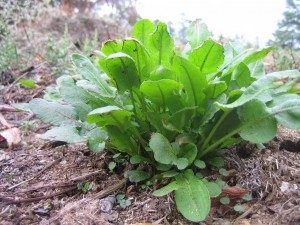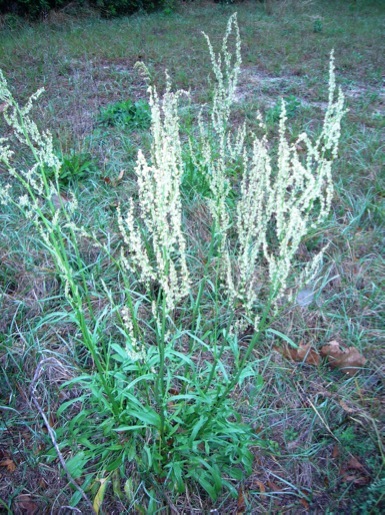Of all the Rumex that grow in the South, Rumex hastatulus is probably the most pleasing. The tart-tasting intensely green leaves are hard to misidentify — edible wise — and the bloom that turns from white to red is pleasing to the eye. Its nickname is the Heartwing Sorrel, describing the mature reddish, winged seed pods.
Because of the leaf shape though, the R. hastatulus is sometimes confused with the also edible Rumex acetosella. R. hastatulus has a tap root and reaches two feet high or more. R. acetosella doesn’t have a tap root and is more mat growing rarely getting above 18-inches high. The R. hastatulus has broadly winged seeds, the R. acetosella does not.
Rumexes are also known as Dock. Actually tall Rumex are called dock and short Rumex are called sorrels. There are some 200 species in the genus. The word Rumex (ROO-mecks) was borrowed is from the Dean Latin name for a similar sorrel in Europe. It comes from Rumo which was taken from the Greek word Rufo, meaning to suck. Romans used Rumix leaves like lollipops. Hastatulus (has-TAT-you-lus) is shaped like an arrow or spear and refers to the shape of the leaves. Acetosella is said ah-kee-TOE-sell-uh, or, ah-see-TOE-sell-ah
Rumexes have long been used in salads and as a potherb. I think they are a great stuffing for that fish you just caught. However, they’re best known in a sorrel soup made by the French. Here’s a sorrel soup recipe to serve six from Fernald and Kinsey’s Edible Plants of Eastern North America, 1958 edition, (though several sorrel soups recipes are available on the internet:)
“Wash (a handful of sorrel) and put in a saucepan with a little water (not covered.) Cook slowly for about a half an hour. Put four cups of milk with a small white onion (whole) in a double boiler. Add two teaspoons of butter, and two tablespoons of flower (blended to avoid lumps) to the hot milk. Let stand and add sorrel. Strain, discard the sorrel, season the soup and enjoy.”
Every book on wild foods warns us not to consume too much oxalic acid, but that’s to keep the accursed lawyers happy. ( Shakespeare was right.) It is true that folks with kidney stones, gout and the like should not over-consume oxalic acid. Yet, when was the last time you read or heard of such a warning for tea, parsley, rhubarb, carambolas, spinach, chard, beets, cocoa, chocolate, nuts, berries, black pepper and beans? They all have oxalic acid as well, but no dire warnings are given with them. The French are not succumbing from sorrel soup slurping. As my Greek ancestors used to say some 3,000 years ago, μέτρον άριστον, [ME-tron A-ri-ston] all things in moderation.
The word “sorrel” is from the High German word sur, meaning sour. Oxalic is from Greek — oksinos, όξινος — and also means sour, and the rumex is mildly tangy because of …oxalic acid… now there’s a surprise. They are refreshing to nibble on, are nice additions to salads. Their tart flavor is both positive and negative. A little is good, but a lot when eaten uncooked, to excess, can leach some calcium out of your bones. (Yes, you would have to consume it like a force-fed lab rat for months, but it can happen.) Rumex, by the way, is in the buckwheat family. Lastly, research on Rumex induratus shows it has antioxidant properties. Let’s hope it runs in the family.
Green Deane’s “Itemized” Plant Profile

Rumex pulcher, native of Europe found through much of the east of the United States west to Texas. Look for hairy stems. Leaves and seeds are edible.
IDENTIFICATION: Moderate plant with white to greenish flowers on a long stalk. Young leaves shaped like a fat sword with hilt, older leaves long and lance-shaped, edges wavy. Great variety, your local rumex may look very different. Get proper identification. R. Hastatulus is a winter annual in Florida. However, I have seen it occasionally in late spring and early fall.
TIME OF YEAR: In February in Florida, springtime elsewhere, can overwinter evergreen in warmer states, can last into summer. It ranges from Central Florida north to New England, west to New Mexico and Montana.
ENVIRONMENT: Old pastures, roadsides, sandy areas, can tolerate a dry conditions.
METHOD OF PREPARATION: Leaves in salad, or made into soup. See recipe. If you cook any Rumex best to use a glass or ceramic pot. Like all plants with oxalic acid should be used in moderation. Some people may be allergic to it.
HERB BLURB
A nettle sting is painful because the sting contains acid. Rubbing the sting with a sorrel leaf or any of the docks/rumex can relieve the pain because they contain an alkali that will neutralize the acid and reduces the sting. The same leaves work well on bees and ants stings but soap or bicarbonate of soda are better, if you have either. Sorrel will not work against wasp stings because they contain an alkali. To neutralize those you need an acid such as vinegar, citric acid, pickle juice even tomato juice.






Thank you Green Deane! I have yet to come across any stinging nettle in California, however, just earlier today i was wondering what plants may grow near urtica that contain alakaloids to combat the sting. I find your site very informative and i love the etymological explanations. Regarding acids and bases and true “organic chemistry”, it makes me wonder about the fact that urushiol in poison oak is said to be relieved with Manzanita leaves which have a high tannin content. I know that tannins act as an astringent much as alcohol does and urushiol is alcohol soluble. I wish these things were explained in our standard school systems.
P.s. No website yet but I’ll be posting my biking and farming adventures through the u.s. At figure8farmer.blogspot
i hope to mostly sustain myself with edible weeds along the way and this site has helped me tremendously!
Reading this week’s newsletter makes my mouth water. Growing up in the 60’s and 70’s my sisters and I spent our summers in East Texas on our uncle’s ranch. We were introduced to the pleasures of sucking on sour-dock leaves by our cousins. I think this may be what led me to Euell Gibbon’s books and foraging. Thank you!!
Maybe I’m in the dark about this plant but not one site mentions chewing on the stalks! 🙂 I grew up chewing on the stalks. I never knew about the awesomeness of the leaves until today. Thanks for that!
I’m in Ruskin, FL and these things have sprung up everywhere around here. Ones with big thick stalks that I know will be juicy, sweet & sour.
I picked some up during my lunch break to chew on at my desk. The stalks taste like they are filled with pink lemonade. 🙂
I just chewed and sucked a few leaves. They’re not nearly as yummy as the stalks.
The very best thing I have ever used for a bee sting was simple household ammonia. It’ll also work for the itchy burning of a spider bite as well. If one was to purchase an “after bite” tube of sting remedy they would find it is simply household ammonia with some mink oil added at a high buck price because the ammonia is a bit drying. Save money and use ammonia or some cheap window cleaner made with ammonia. As far as stinging nettle goes…I have harvested it so much and so long that it no longer bothers me and I can often harvest completely barehanded. I even eat it raw after rolling the plant tips between my finger and thumb to break all the little nettle barbs. Does anyone know if this variety of (sheep) sorrel is the same one used in essiac tea (famous native American anticancer remedy)? Want a nice laugh? … I was picking and eating some raw nettle tips by my daughters home while taking my grandson for a walk to gather some wild rosehips…. the young fellas who were the grounds keepers saw me doing this and decided to pick some themselves to get high……. Even my two year old grandson knows better than to pick nettles barehanded. I wonder what they thought the next week when I picked some scrub willow tips for a headache?
From what I understand, sheep sorrel and heart-wing sorrel are two completely different types of sorrel, as explained at the beginning. Hope this helps!
Green Deane, if oxalic acid binds with calcium in the body, have you ever heard of it being used to decalcify plaque hardened in the arteries? I’ve been looking for studies but wonder if you’ve come across anything in your reading. Thanks, Nick
No, but vitamin K2 is supposed to do that.
To clean the arteries of decalcified plaque you might want to look at Lecithin granules. It acts as an cleaner and is made of soybeans so look for one that is Non- GMO. I know Now has one like this.
k
Thanks… I personally try to avoid all unfermented soy products because of its estrogenic effects.
You are right about Soy and the estrogenic effects. Many people are still not aware of that, but for women with hormonal imbalances, Soy products ie: Soy Milk, etc can cause the problems to be worse.
I used to grow up like many children in the south snacking on Sorrel. Which we called “Sour Weed.” We saw green and red varieties and it always reminded me of a small version of Rhubarb. We also chomped down on May Pops, and ate the drop of nectar in Jasmine and Honeysuckle..
While I was growing up here in Beaufort, SC our schoolyard was inundated with this pleasant plant. Using the children’s method of identifying flora we of course named it Sour Grass. We were forbidden to pick it and actually punished if we ate it but how do you stop children from eating candy when it is so plentiful? However, as Indigoazure stated, we munched the stalks, not even knowing the leaves were consumable. Now that I have garnered this knowledge, I can recapture one of the delights of my childhood.
I’m a bit confused here…I grew up in the midwest and the plant we called sheep sorrel didn’t look anything like this , it was a ground hugging plant with leaves similar in shape to a shamrock but with a reddish/purplish coloring. It was just as tasty as has been described here, being bitter-sour with a hint of citrus.
Common names are nearly worthless. It sounds like you are describing an Oxalis, which I have an article or two about.
I am pretty sure, what you describe is a Wood Sorrel
Some websites claim this is poisonous to livestock. I’d like to cultivate it but would hate it to take off like a weed and cause my animals problems. What do you think. Heck, I’ve seen that leaf shape on my property for certain and wondered if it was a kind of dandelion.
Sheep sorrel is an ingredient in eccaise herbal cancer cure, throw in some burdock root, slippery elm bark, and turkey rhubarb, and you’ve got a medical powerhouse?
Is it only the leaves that are edible? What about root, flowers, seed? Thanks.
Seeds or Rumex are eaten and I would think flowers would be edible. The root might just be too bitter.
I was reading that red sorrel (aka sheep sorrel) has the ability to improve eyesight, slow aging, reduce skin infections, strengthen the immune system, and improve digestion. It may also build strong bones, increase circulation, boost energy levels, lower blood pressure, increase appetite, strengthen heart health, and hinder cancer cell growth.
What are the healing properties of heart-wing sorrel, if any? And in what form? Tincture? Salve? etc.
Thank you, in advance!
KT